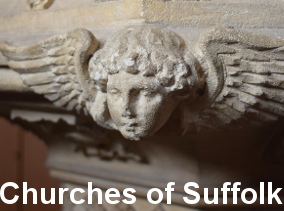
e-mail simon@suffolkchurches.co.uk
All Saints RC, Leiston
| Before the Reformation, Leiston's
Catholic Priests ministered at St Margaret, to the west of the village, now in the care of
the Church of England, and completely rebuilt in the
1860s. Today, we'll find them at All Saints, which is on
the road to Aldringham, out in Leiston's dreary suburbia. It is
actually a daughter church to Our Lady and St Peter, Aldeburgh, some three miles away. Because of this, it
sits rather folornly on its own, without a presbytery to
keep it company.
Stormy day in Leiston. Probably, it looks quite different with the lights on. And, as there is no priest at hand, you can't get in, because the church is locked, which no Catholic church should be; although I should add, in fairness, that Aldeburgh is kept open.
|
| Parishioner Mark Pattinson tells me
that the church was built by the combined efforts of
locals and mainly Irish workers during the construction
of Sizewell A power station. Up to that point, the
congregation of Leiston had to make do with a wooden hut.
As Mark says, this reveals something of the flavour of
the Leiston community itself, historically tolerant and
welcoming to outsiders. And what is a town if not the people who live in it? Leiston may not have the architectural splendours of neighbouring Aldeburgh, but Mark remembers the welcome his grandfather received as an Italian emigrant, and commends the friendliness of the place to us. The same could not be so easily said of Aldeburgh, I suspect. I am glad that I know something of the history of this little building. Otherwise, a locked church on the edge of this undistinguished little town might lead you to conclude that the Church in Leiston is beleaguered; but in fact this is a busy, thriving Christian community. All Saints, Leiston, can be found on Seaward Road, to the south of the town. Follow the main street towards Aldringham. It is kept locked, and the Parish Priest lives at Aldeburgh. |